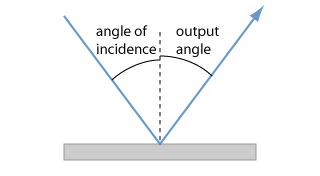Specular Reflection
Definition: reflection of light where the angle of reflected light equals the angle of incident light, but on the opposite side of the surface normal
Alternative term: regular reflection
German: spiegelnde Reflexion
How to cite the article; suggest additional literature
Author: Dr. Rüdiger Paschotta

The classical type of light reflection is that of specular reflection, from from the Latin word speculum (mirror), or alternatively regular reflection. That kind of reflection is encountered on smooth surfaces, e.g. of polished metal or glass pieces, including cases with total internal reflection, or on surfaces of liquids. Here, the angle of the reflected light, as measured against the surface normal, equals that angle for the incident light (see Figure 1). That situation is usually found with high accuracy on various types of flat mirrors. For curved reflecting surfaces, one also obtains a specular reflection; the angles of incidence and output are then measured against the local normal direction.
The common law of reflection (output angle = angle of incidence) is related to the fact that the component of the wave vector along the reflecting surface is preserved.
Other Kinds of Reflection, Involving Scattering of Light
If the reflecting surface is nearly flat, but not completely flat, the output light may be spread over some range of angles; that is called diffuse scattering. With a substantially rough surface, causing significant scattering, there can be a substantial angular range, for example with a width of 10°. Particularly volume diffusers, but also some matte paints, tend to produce even a much wider angular distribution of scattered light, often even approaching the standard case of a Lambertian scatterer. That can be considered as the opposite of specular reflection: perfectly diffusing reflection. There can be also a combination of specular and diffuse reflection; an object with such properties exhibits specular highlights (depending on the illumination conditions) in addition to the appearance generated by diffuse scattering.
Specular reflections can appear much brighter than diffuse reflections, when seen from a large distance, because the reflected light is concentrated to a smaller range of directions. (That can be a problem in the context of laser safety.) On the other hand, specular reflections remain unnoticed for an absorber if the reflected light misses his or her eyes.
Condition for Specular Reflection
Because the wavelengths of visible light are rather small (well below 1 μm), pure specular reflection requires a high degree of surface flatness – much more than for microwaves, for example. Therefore, a metal surface, for example, needs to be very carefully polished to obtain nearly perfect specular reflection.
Reflections on Diffraction Gratings
A modified form of specular reflection can occur on diffraction gratings. Here, the output angle can substantially deviate from the angle of incidence, and also depends on the optical wavelength, but there is again no diffuse reflection in the ideal case.
Specular Reflection in Imaging
Specular reflections can be used for imaging – for example, in reflective telescopes. In contrast to diffuse reflection, where random angular changes are introduced, the image information is preserved upon specular reflection. However, diffuse reflectors can still be useful as screens in certain imaging instruments; such a screen needs to be placed in an image plane.
Questions and Comments from Users
Here you can submit questions and comments. As far as they get accepted by the author, they will appear above this paragraph together with the author’s answer. The author will decide on acceptance based on certain criteria. Essentially, the issue must be of sufficiently broad interest.
Please do not enter personal data here; we would otherwise delete it soon. (See also our privacy declaration.) If you wish to receive personal feedback or consultancy from the author, please contact him e.g. via e-mail.
By submitting the information, you give your consent to the potential publication of your inputs on our website according to our rules. (If you later retract your consent, we will delete those inputs.) As your inputs are first reviewed by the author, they may be published with some delay.
See also: mirrors, scattering, reflectivity
and other articles in the category general optics
 |



If you like this page, please share the link with your friends and colleagues, e.g. via social media:
These sharing buttons are implemented in a privacy-friendly way!